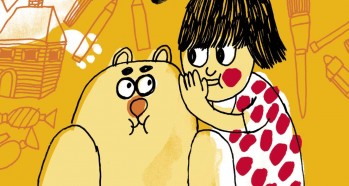Search results for "lola rogers"
Is less really more? On new books for young readers
18 December 2014 | Articles, Non-fiction
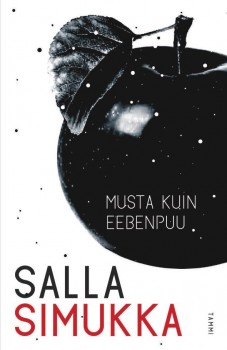
Black as ebony: volume three of the ‘Snow White’ trilogy for young adults by Salla Simukka
This year has been an eventful for Finnish literature in many ways, not least in terms of young adults’ and children’s books. The full ramifications of Finland’s turn as the theme country at this year’s Frankfurt Book Fair will only be known with the passage of time, but more mega-success stories to stand alongside Salla Simukka’s Lumikki (Snow White, Tammi) trilogy for young adults – now sold to almost 50 countries – are eagerly awaited. Visitors to the Frankfurt Book Fair also got a look at Finland-Swedish illustration at the By/Kylä (‘Village’) stand, which presented varied works by nine illustrators and animators in a memorable exhibit.
Book sales continue to fall in Finland. The major general-interest publishers – WSOY, Tammi, and Otava – have cut back on Finnish titles and are concentrating on high-sellers and proven authors.
Books in series are now a dominant phenomenon in literature for children and young adults, aiming to win readers’ loyalty with their continuing stories and characters. Many longtime authors and illustrators of books for children and young adults have had to look for new contacts, and publishers are increasingly hesitant to launch debut artists. More…
Jenni Erkintalo: Värejä meressä [Colours in the sea]
29 January 2015 | Mini reviews, Reviews
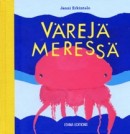 Värejä meressä
Värejä meressä
[Colours in the sea]
Kuvitus [Ill. by]: Jenni Erkintalo
Helsinki: Etana Editions, 2014. 32 pp., ill.
ISBN 978-952-7105-00-9
€17.90, hardback
In recent years a large number of board books have appeared in Finland: many of the graphic artists and designers of the younger generation have taken an interest in them. The style is generally modern, but unfussy and easy for a child to make sense of. Graphic artist Jenni Erkintalo’s (born 1978) picture book debut is ebullient, in all its simplicity. With supple rhyming text and minimal drawings, little readers are guided through the beginnings of learning colours. The three primary colours give birth to new colours and the illustrations demonstrate the mixture of colours in a fun way. The book has thick cardboard pages that can stand up to even a two-year-old’s rough handling.
Translated by Lola Rogers
Who for? On new books for children and young people
29 January 2010 | Articles, Non-fiction
Books have a tough time in their struggle for the souls of the young: more titles for children and young adults than ever before are published in Finland, all of them trying to find their readers. Päivi Heikkilä-Halttunen picks out some of the best and most innovative reading from among last year’s titles
Nine-year-old Lauha’s only friend and confidant is her teddy bear Muro, because Lauha is an outsider both at home and at school. The children’s novel Minä ja Muro (‘Muro and me’, Otava), which won the 2009 Finlandia Junior Prize, provoked discussion of whether it was appropriate for children, with its oppressive mood and the lack of any bright side brought into the life of the main character in its resolution. More…
The faraway island
31 March 2007 | Archives online, Fiction, Prose
Kaukainen saari, a short story from the collection Elämän ja kuoleman pidot (‘The feast of life and death’, 1945). Introduction by Juhani Niemi
For as long as they could remember, Hannes and Pekka had felt a great fascination for the lonely little island out in the open sea, clearly visible from the shore at home. Thickly overgrown with unusually tall pines, the island was like a wondrous bouquet in a great vase of sea. It was in sunshine from morning till night. At the very instant that the tip of the sun peeped up over the horizon, its rays were already caressing the tops of the little island’s tallest trees, and when the sun set behind the blackness of the islands to the west, those same treetops were tinged with a bright, hot glow. The winds and storms touched it more vehemently than any other place. No matter which direction the wind came from, the island was always defenseless, but, happily, ready for anything. In stormy weather the waves flung themselves against its stony shore and sometimes nearly as high as the treetops. The wind roared in the dense branches of its trees more wildly and violently than anywhere else. When it rained, it was as if the island were hiding among the grey curtains of mist, looming dimly and secretly. In the autumn, when all the other woods were splashed along their flanks with yellow and russet, and gradually undressed until they were half-naked, the little island’s tall pine trees rose up from the grim autumn surf as lush and green as always. And in the winter, when the sea froze and snow covered everything in a mantle of white, the island dressed itself in ice and rimy frost like royal robes covered in millions of sparkling diamonds. More…
Saku Heinänen: Zaida ja lumienkeli [Zaida and the snow angel]
29 January 2015 | Mini reviews, Reviews
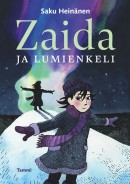 Zaida ja lumienkeli
Zaida ja lumienkeli
[Zaida and the snow angel]
Kuvitus [Ill. by]: Saku Heinänen
Helsinki: Tammi, 2014. 207 pp., ill.
ISBN 978-951-31-7631-0
€25.90, hardback
The adopted child’s story is already a familiar one from old classics of girl’s literature. This debut novel by Saku Heinänen, the story of Zaida, a girl adopted from India, draws on this tradition, yet Heinänen (born 1968), a professor in graphic design at Aalto University, succeeds in creating a fresh and original setting and sympathetic central characters. Zaida is used to talking openly with her parents, but bullying at school makes her withdraw into her shell. She gets her strength from a soul sister who understands her bad moods. This tension is what gives this novel its extraordinary suspense. Heinänen’s book doesn’t paint a child’s everyday life as idyllic – there are many kinds of secrets in one little family. Zaida’s uncle is prone to drink and melancholy, but the two are still close. Heinänen also illustrated the book and designed his own font – Freya – just for the book. His wife is children’s book author and illustrator Christel Rönns.
Translated by Lola Rogers
Vilja-Tuulia Huotarinen: Kimmel
5 February 2015 | Mini reviews, Reviews
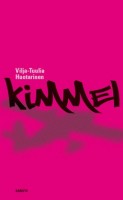 Kimmel
Kimmel
Hämeenlinna: Karisto, 2014. 120 pp.
978-951-23-5840-3
€22.90, hardback
In Kimmel, Vilja-Tuulia Huotarinen, known also for her poetry, presents no fewer than 12 teenage girls whose fates are left to be pondered long after the story is completed. Kimmel is a girl hero whose parents place the rescue of the entire planet on her shoulders. She has no doubt she will succeed in her task. She acquires a small pink airplane decorated with glitter – even though ‘there’s really nothing soft and pretty and hello-kitty about sixteen year olds’. For her companion on this epic trip Kimmel gets an interactive night book that empathises with her feelings and sometimes gives her concrete advice. Kimmel can be seen as a modern version of classic girl’s books – the author plays with girl’s book clichés but challenges the reader to think about myths of womanhood and the limits set by society. Huotarinen writes about the explosions of joy and the depths of sadness in girlhood with magical poignance and poetry.
Translated by Lola Rogers
Nordic prize to Sofi Oksanen
31 March 2010 | In the news
The Nordic Council’s Literary Prize 2010 has been awarded to Sofi Oksanen for her novel Puhdistus (‘Purge’, WSOY, 2008).
The winning novel was selected by a jury from a shortlist of 11 works from the Nordic countries. The prize, worth approximately 47,000 euros, will be awarded in Reykjavik in November.
The novel, about women’s fates in the violent history of 20th-century Estonia, was awarded both the Finlandia Prize for Fiction and the Runeberg Prize in Finland, where it has sold more than 142,000 copies.
So far publication rights have been sold to 27 countries; the English translation, by Lola Rogers, will appear next month in the US, published by Grove Press.
Maija & Anssi Hurme: Lepakkopoika [Batboy]
5 February 2015 | Mini reviews, Reviews
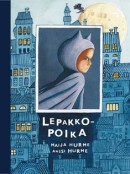 Lepakkopoika
Lepakkopoika
[Batboy]
Kuvitus [Ill. by]: Maija Hurme
Helsinki: Schildts & Söderströms, 2014. 27 pp., ill.
ISBN 978-951-52-3361-5
€22.90, hardback
Fladdermuspojken
Kuvitus [Ill. by]: Maija Hurme
Helsinki: Schildts & Söderströms, 2014.
ISBN 978-951-52-3326-4
€28.90, hardback
Bat boy is a compact picture book with sparse text and abundant pictures that are well-balanced – there is never too much or too little of either. A six-year-old named Ilmari changes into a bat boy who stalks people in the dim of evening. The book describes the feelings of a boy approaching school age with sensitivity – the story deals with defiance of adult authority, rules and restrictions. Ilmari can also be thought of as a special child who experiences the world differently than other kids his age. The day care he attends is presented in both text and pictures as a prison and the adult day care workers as guards. Maija Hurme’s watercolour illustrations have an anarchic energy. The comic strip narrative supports Ilmari’s feelings of aggression. His fantasies are presented as blue-toned photographs with white borders, but the colours of the home and park settings glow with a message of safety, caring and trust.
Translated by Lola Rogers
In one hundred springtimes
23 November 2012 | Extracts, Non-fiction
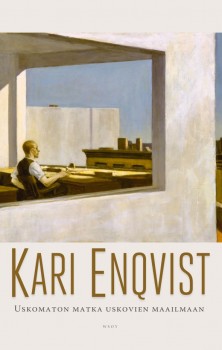 Extracts from Uskomaton matka uskovien maailmaan (‘An unbelievable journey into the world of the believers’, WSOY, 2012)
Extracts from Uskomaton matka uskovien maailmaan (‘An unbelievable journey into the world of the believers’, WSOY, 2012)
In his new book the writer, professor of cosmology, a scientist without a religion Kari Enqvist explores religiosity, how it manifests itself in present-day Finland, in various churches and parishes. How will the expanding scope of science and secularisation change the world and the forms of spirituality in the course of the next century?
When, in July 1969, Neil Armstrong climbed down the ladder on to the surface of the Moon, it was a huge propaganda coup for both the United States and the scientific world view. Manned space flights as a way of gaining knowledge are both ineffective and brain-numbingly expensive, but it is hard to imagine a stronger individual and universally understandable demonstration of the superiority of the scientific world view than an astronaut on the surface of a foreign celestial body. Everyone can recognise it as a triumph of both engineering technology and the hard sciences.
But the astronaut solution has been tested already, and I do not believe that space travel will expand our consciousnesses in the next century. It is possible that we will not even have visited Mars. Fantasies about manned flights to other stars are, in my opinion, utopian in the extreme and I do not really believe that humans as physical beings will ever leave the solar system. Journeys to the stars are inconceivably long and so expensive that they cannot be embarked on merely in order to fulfil the Buck Rogers fantasies of teenage boys. Carrying humans to the closest one, alpha Centauri, a mere four light years away, would take, at best, hundreds of years (we can dismiss rockets that travel at the speed of light as mere scientific fantasy). Even if deep-freezing to slow vital functions were possible, it would make as much sense to pay hundreds of billions to freight pig carcasses to the planets. For everything that human beings can do can be done better – and, more importantly, more cheaply – by machines. Even if the spirit were willing, the flesh is so weak that silicone beats it hollow.
So it is my guess that in place of the macrocosmos the scientific world view will seek consolidation in the microcosmos. As a cosmologist, I am not happy to admit this, but admit it I must. More…
Time walks slowly
30 June 2002 | Fiction, poetry
When Eira Stenberg (born 1943) began writing in the heat of of Africa, her pen sank into the paper like a tattooing needle into the skin, she says. Her experiences there are alive in her book of poems entitled Siksi seurustelen varkaiden kanssa (‘That’s why I consort with thieves’, Tammi, 2002)
The journey
Wheels clattering, landscape speeding by the window to the past
notebook on lap she understood the journey’s essence,
that it’s a lap she lost in early childhood
when she stood up and set off walking
away from the arms that had carried her from room to room
giving views from on high as if from a mountain:
the apparitions of things, the furnishings, the tints of pictures
and the bedroom mirror they arrived in,
mother and a child, a holy image she met
again in churches and on altars everywhere
as if it were the purpose of the journey: More…

